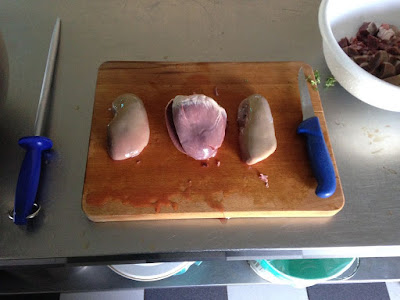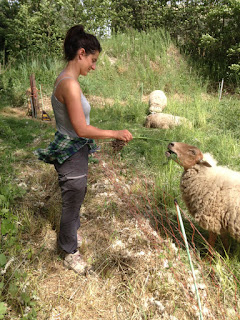On a bright Sunday
evening in early June we took the train to Eindhoven (NL), from where we took a
bus that took us way into the countryside. The province of Brabant where we
were in is not a very densely populated one. The sandy soils there are not very
good for farming, so that is why they specialised in pigs; currently there are
about twice as many pigs as people. Needless to say, that was exactly what we
were coming for; albeit not for the nasty dark-concrete-floor-wire-cage pig
farms, but for one raising organically grown heritage breed slow growing pigs,
more about that later.
On the road again
From the bus stop in a tiny village (church, square, two bars and one
supermarket) we were picked up by Teresa, the woman who together with her
husband Peter ran the farm we were going to visit. We arrived at their place,
and after some wine, peanuts and small talk we went to bed.
Their foodtruck: you can find them every Saturday on Tillburg market (Dutch people go there!)
The farm itself was a
beautiful 19th century building where Peter had lived his whole childhood, his
dad had been a pig farmer before him. Teresa used to be an artist (very visible
throughout the house), but moved in with Peter after they met, and had taken on
the role of farmer’s wife and butcher. As she said it: “Peter takes care of the
living animals, and I take care of the dead ones”. The next day we would see
what she meant by that, as she showed us her drying room, where some lovely
hams and salami sausages were hanging to dry and become tastier by the day. The
killing itself was not done by her, but by a professional slaughterhouse some
15 minutes away. From there they would get the pig back in six pieces, which
she would further process and turn into sausages, coppa, ham, salami,
meatballs, hamburgers and of course lard.
Going HAM
"Bacon is good for me"
Throughout the two weeks, our main tasks involved feeding and cleaning up after the pigs, tending to the garden (weeding, planting and harvesting) and helping Teresa in her kitchen/butchery.
Doing crépinette, more or less with conviction
Heart and kidney to be minced and made into spicy meatballs
Some bacon from the chin
Butchery hat selfie
About the pigs themselves then: it is important to
know what differentiates the pigs on this organic farm from the ones you would
normally encounter in the supermarket. The biggest difference has to do with
fat, or better said, the lack of it. That is because apparently customers want
pork without a lot of fat and just a lot of cheap protein for their money. That
is why breeders have created the well-known pink cross-breed, with the best
so-called “feed conversion ratio”. That basically means you can stuff this pig
with cheap Brazilian soy beans, and it will just get bigger very fast, without
getting fat. The dream of every body-builder you would say! Unfortunately when
the fat goes, the taste goes away along with it, so that you are left with a
tasteless piece of watery proteins. Furthermore, these pigs are butchered at
the age of five months, which is way too young to develop any taste whatsoever.
Not so much at Peter and Teresa’s farm though. First of all, they did not work
with this pink hybrid designer crossbreed, but with an almost extinct
Dutch-German race called Bonte Bentheimer. This type of pig grows rather slowly
(one year to full-grown size), and if you overfeed it, it will just get fat;
that is why Peter put these pigs on strict rations. Furthermore, these pigs had
access to the outside, where they could run around, play and dig with their
noses for roots. That way, they get some nice intramuscular fat (think Wagyu
beef here) and of course they are much happier by it. Finally, for what it’s
worth, they also listened to classical music throughout the day, and were fed
on leftover bread from an artisanal organic bakery closeby!
Jef grinding the bread
Pieces of organic bread that made us hungry!
Needless to say, we had two very nice weeks at this
farm, where we learned a lot about growing heritage breed pigs, and making sure
they had the best life possible. Myself, I have become quite enchanted with the
idea of raising some heritage breed pigs one day. Maybe not quite these ones,
but another one that is on the list of endangered races. That way, we’ll save
them by raising them and eating them, and I think that is a wonderful thing.
Jef
Gertrude. My best friend on the farm. I think she had a crush on me.
Jef trying to be serious for two photos. So I took three.
Trimming hedges, excellent upper body workout.

















